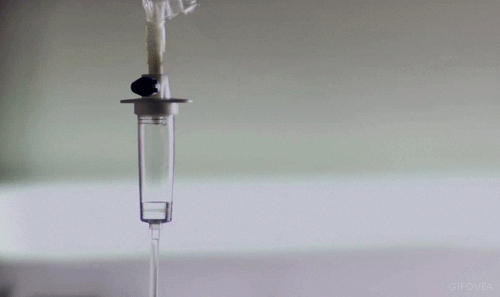Gravity Drips
In most hospitals in Canada, every intravenous fluid and medication is given through an automated IV pump. In extreme cases, if there aren't enough pumps for each patient, simple fluids can be run by gravity, but ANY medication must be run on a pump. This is A) super convenient/time saving and B) a strong safety mechanism. I shall explain, in case you aren't familiar.When using an IV pump, one must simply prime your tubing (fill it with saline so there's no air bubbles), stick said tubing into the pump, punch in the rate you want your fluid or medication to run at, program in a volume limit, attach it to the patient, and press start. The pump now knows how fast to infuse the fluid, and when to stop before the fluid runs out. It can also do fancy things like have one medication run then switch back to the fluid line when the med is done, or run both lines concurrently. The pump will stop if it detects air in the line. The pump will not run if you try to run too much fluid too fast. And (if you use the fancy built-in drug library), it will even tell you if your infusion rate is faster than the recommended parameters.
The pump also gives off very unpleasant but helpful BEE-BEEP! BEE-BEEPS! When it requires attention due to any one of the above issues.
Here on the AFM, we have a grand total of...maybe 10 pumps (I might be being generous with that number too). So they are ONLY used for extremely high-risk medications which must be delivered at a precise rate. The rest of our IVs are run by gravity. Meaning, you hang the bag, prime the tubing, and plug it directly into your patient. You must then adjust the rate manually, with a roller clamp, COUNTING the number of drips in a minute, then doing some fancy math (using a standard drip volume - usually 15 drips = 1 mL). This means sitting there for 5 minutes or so, counting for 15 seconds, multiplying that by 4, no that's too fast, ever so slightly close the clamp, count for 15 seconds, multiply by 4, nope. Too slow. Etcetera. It's oodles of fun.
It also requires a lot closer attention, because when your fluid runs out you have to be right there right then to change the bag, or you get air in the line. It also means it's really easy to accidentally run something to fast, or accidentally leave it stopped completely, which (if left long enough), can potentially lead to an occluded IV that no longer works. Meaning you have to poke your patient AGAIN. *sad face.*
Adults Aren't Adults
In the developing world, being 18 often doesn't mean you're an adult (medically speaking, anyways). Quite a lot of our patients (especially the women) who are 20-70 years old are teeeeny weeeny. Most are around 35-40 kg (~75-90 lb). They're skin and bones. Everyone receives multivitamins while here, and many also require nutritional supplements like boost or ensure, or this weird "mana" stuff that's like an entire meal's worth of nutrition in a little peanut-buttery packet. |
| Mmm. Appetizing, isn't it? |
Most of our obstetric fistula patients tend to be small, as their malnutrition is usually a major causal factor in their fistulas. They stop growing very young, due to their lack of nutrition, and as such, their pelvis never fully develops. Many also get married quite young. Trying to deliver a big-honkin baby head through an under-developed pelvis (in an isolated village with extremely limited or non-existant healthcare) equals extremely long labour times (i.e. DAYS of labour). This continuous pressure then causes the fistula to form, and not only do they have to face the horror of a still-born baby, but also a lifetime of shame and ostracism.
Anyways. The other main reprecussion of this low weight is that we have to use pediatric dosing for the majority of our adult patients. This means calculating each dose specifically for their body weight, and double checking EVERY med with another nurse before giving it. Even a simple tylenol. This seems like a miniscule complaint compared to what these women have been through, so I think I can live with it.
Everybody's a patient.
I forget if I mentioned earlier, but all of our pediatric patients (the real ones, the ones who are under 18) must have a caregiver with them while they are on board. This is nice, because mama or papa does the great majority of the patient's care. They wash them, they carry them to the toilet, or change their diaper if they're too little for the toilet. Yay! This is great.
The weird thing about this, though, is that the caregivers often become pseudo-patients. We may notice they may have a cough, wheeze, or rash, so we treat it. Because, uh, we can. So why wouldn't we? We actually have standing orders for tylenol and benadryl that we can give to ANYONE (the patient's parent, the patient's baby brother, the patient's baby daughter, the day crew, etc). They get a little medication record that we stick at the front of the actual patient's chart, and the doctor will sometimes add some orders for antibiotics or some such as well. This seems especially counter-intuitive to my westernized brain, because at home we would have to say, "Sorry, you have to see your family doctor, or visit the ER."
It's kind of awesome, actually. When you don't have to worry about insurance or tax dollars, caring for people is ever so much simpler.




No comments:
Post a Comment